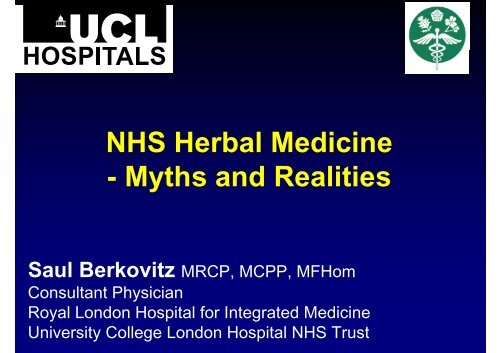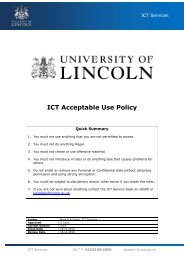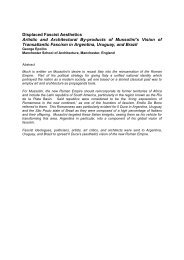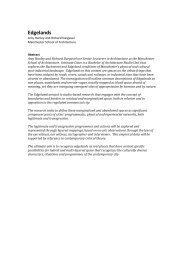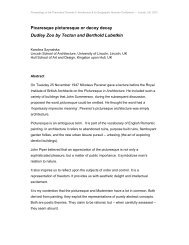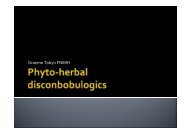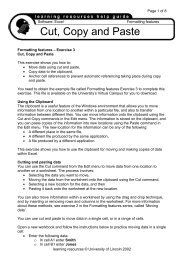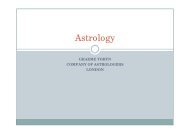NHS Herbal Medicine - Myths and Realities - University Of Lincoln ...
NHS Herbal Medicine - Myths and Realities - University Of Lincoln ...
NHS Herbal Medicine - Myths and Realities - University Of Lincoln ...
Create successful ePaper yourself
Turn your PDF publications into a flip-book with our unique Google optimized e-Paper software.
<strong>NHS</strong> <strong>Herbal</strong> <strong>Medicine</strong><br />
- <strong>Myths</strong> <strong>and</strong> <strong>Realities</strong><br />
Saul Berkovitz MRCP, MCPP, MFHom<br />
Consultant Physician<br />
Royal London Hospital for Integrated <strong>Medicine</strong><br />
<strong>University</strong> College London Hospital <strong>NHS</strong> Trust
The phytotherapy clinic, RLHIM<br />
• 2007-<br />
• Integrated with orthodox <strong>and</strong> other forms of<br />
complementary medicine<br />
• ‘Generalist’ secondary care setting<br />
• Severe complex chronic disorders
• Quality<br />
• Safety<br />
Aims of the clinic<br />
• Effectiveness<br />
• Clinical practice<br />
• (Teaching)<br />
• (Research)
Methods<br />
• Development of <strong>Herbal</strong> Formulary<br />
– Based on safety, not efficacy<br />
Risk rating performed by two RLHIM pharmacists<br />
– Red (High Risk)<br />
– Amber (Moderate Risk)<br />
– Green (Low Risk)<br />
– Unknown<br />
• Tinctures / pills but no loose dried herbs<br />
• Stringent QA vetting of suppliers
• Documentation<br />
Methods<br />
– Access database in doctor’s office <strong>and</strong> pharmacy<br />
– Labelling function<br />
– Dispensary<br />
– One specialist herbal pharmacist<br />
– Training for other pharmacists<br />
• Checking for interactions<br />
– Current medication card<br />
– Pharmacist double-check against interaction data
SINGLE HERB OR FLEXIBLE COMBINATION<br />
FIXED COMBINATION<br />
GENERALLY SMALLER GENERALLY LARGER DOSES<br />
DOSES<br />
SINGLE CONDITION WIDER VIEW OF HEALTH<br />
USUALLY TABLETS USUALLY TINCTURES<br />
STANDARDISED USUALLY UNSTANDARDISED<br />
SOME “EVIDENCE BASE” LITTLE OR NO “EVIDENCE BASE”
<strong>Herbal</strong> Evidence base<br />
• ~5000 r<strong>and</strong>omised controlled trials on Medline<br />
• 353 Systematic reviews in <strong>NHS</strong> Evidence<br />
• No herbal medication yet approved in any<br />
NICE guidelines
Positive<br />
• St John’s Wort for depression<br />
• Horse chestnut for symptoms of varicose veins<br />
• Gingko for intermittent claudication<br />
• Kava for generalised anxiety syndrome*<br />
• Peppermint oil for irritable bowel syndrome<br />
• Devil’s claw <strong>and</strong> willow bark for acute exacerbations of<br />
chronic low back pain<br />
• Cranberries for prevention of urinary tract infection<br />
• Agnus castus for premenstrual syndrome<br />
• Andrographis for acute upper respiratory tract infection
Major depression –<br />
Cochrane review of St John’s Wort<br />
• Mild to moderate depression<br />
• 29 studies, 5489 patients (30 to 388)<br />
• 18 v placebo<br />
• 17 v st<strong>and</strong>ard antidepressants<br />
Linde et al 2008
Depression – St John’s Wort<br />
Major depression<br />
RR = 1.15 (95% CI 1.02-1.29)<br />
Mild to moderate depression<br />
RR = 1.71 (1.40-2.09)<br />
Compared with SSRI’s<br />
RR = 0.98 (0.85-1.12)<br />
Compared with tri- or tetracyclics<br />
RR = 1.03 (0.93-1.14)<br />
Linde et al 2008
NICE guideline on depression 2010<br />
10.9.5 Clinical summary<br />
St John’s wort is more effective than placebo on achieving response<br />
in both moderate <strong>and</strong> severe depression, <strong>and</strong> on reducing symptoms<br />
of depression in moderate depression.<br />
There appears to be no difference between St John’s wort <strong>and</strong> other<br />
antidepressants, other than in moderate depression where it is better<br />
at achieving response <strong>and</strong> in severe depression where it is less<br />
effective than low-dose antidepressants in achieving response.<br />
However, St John’s wort appears as acceptable as placebo <strong>and</strong> more<br />
Acceptable than antidepressants, particularly TCAs, with fewer people<br />
leaving treatment early due to side effects <strong>and</strong> reporting adverse<br />
events.
NICE guideline on depression 2010<br />
Recommendation<br />
• Although there is evidence that St John’s wort may be of<br />
benefit in mild or moderate depression, practitioners<br />
should:<br />
• not prescribe or advise its use by people with<br />
depression because of<br />
– uncertainty about appropriate doses<br />
– persistence of effect<br />
– variation in the nature of preparations<br />
– potential serious interactions with other drugs (including oral<br />
contraceptives, anticoagulants <strong>and</strong> anticonvulsants)<br />
• advise people with depression of the different potencies<br />
of the preparations available <strong>and</strong> of the potential serious<br />
interactions of St John’s wort with other drugs.
Rheumatic complaints – Litozin<br />
• St<strong>and</strong>ardised rosehip extract<br />
• Anti-inflammatory<br />
• In OA (v placebo)<br />
– Two crossover RCT’s (n=112, 94; 24w)<br />
– One parallel RCT (n=100, 16w)<br />
• In RA (v placebo)<br />
– One parallel RCT (89, 24w)<br />
• Adverse effects insignificant<br />
• No known interactions<br />
• Available in UK<br />
Christensen Osteo Cart 2008
Butterbur (Petasites hybridus) for migraine<br />
• Systematic review<br />
– 2 placebo-controlled RCT’s<br />
– 293 participants, 12-16 weeks<br />
– 15% less migraine per month<br />
– 15% greater response rate v placebo<br />
• No major adverse effects*<br />
• Available in UK<br />
Agosti et al Phytomedicine 2006
Vitex agnus castus for<br />
premenstrual syndrome<br />
• Pituitary dopaminergic agonist<br />
PMS<br />
• v placebo (n=170, 12w)<br />
– 52% vs 24% responder rate<br />
• V placebo (Chinese) (n=202, 3 cycles)<br />
– 80% vs 50% responder rate<br />
• Versus fluoxetine (41,8w)<br />
– Similar effectiveness<br />
Cyclical mastalgia<br />
• Versus placebo (97,12w)<br />
Schellenberg BMJ 2001; He et al, Maturitas 2009;<br />
Halaska et al Breast 1999; Atmaka et al Psychopharmacol 2003
Diagnosis <strong>and</strong> treatment of premenstrual<br />
disorders – expert review 2011<br />
O’Brien et al BMJ 2011
Echinacea for URTI –<br />
Cochrane review<br />
• 16 studies, 22 comparisons<br />
• 14 treatment studies (2190 participants)<br />
• 2 prevention studies (411 participants)<br />
• Meta-analysis not possible due to different<br />
products <strong>and</strong> doses<br />
• Possible benefit for treatment (9 “positive”, one<br />
“trend”, 6 “negative” comparisons v placebo)<br />
• No benefit for cold prevention (3 negative<br />
comparisons v placebo)<br />
Linde et al 2009
Echinacea for URTI treatment<br />
• 719 adult patients with new onset common cold<br />
• Patients were r<strong>and</strong>omly assigned to 1 of 4 parallel groups:<br />
– No pills<br />
– placebo pills (blinded),<br />
– echinacea pills (blinded),<br />
– Echinacea pills (unblinded, open-label).<br />
• Echinacea groups received ~ 10.2 g of dried echinacea root for 24<br />
hours, then 5.1 g/d for 4 days.<br />
• 10% improvement (non-significant) in mean global severity for<br />
Echinacea (blinded) vs placebo<br />
• 7% reduction (0.5/7 days) (non-significant) in mean illness duration<br />
with Echinacea (blinded) v placebo<br />
Barratt et al Ann Int Med 2010
Andrographis paniculata for URTI<br />
• Two systematic reviews<br />
• Seven r<strong>and</strong>omised controlled trials (n = 896)<br />
• All trials moderate to high quality<br />
• Superior to placebo in alleviating symptoms<br />
of URTI (p
Promising<br />
• Turmeric, Aloe vera for ulcerative colitis<br />
• Wormwood for Crohn’s disease<br />
• Cat’s claw, Boswellia, rosehip* <strong>and</strong> comfrey leaf<br />
cream for osteoarthritis<br />
• Rosehip for rheumatoid arthritis<br />
• Rhodiola for depression<br />
• Globe artichoke, chilli pepper, Iberogast (multiherb<br />
extract), peppermint oil / caraway oil for functional<br />
dyspepsia<br />
• Pelargonium for acute bronchitis* <strong>and</strong> COPD<br />
exacerbation<br />
• Sinupret® for acute sinusitis*<br />
• Topical products for skin diseases
Topical products for skin conditions –<br />
Atopic eczema<br />
• Atopiclair (liquorice /<br />
grape seed extract)<br />
• St John’s Wort cream<br />
Psoriasis<br />
• Mahonia aquifolium<br />
cream<br />
• Indigo naturalis cream<br />
‘promising’ research<br />
Acne vulgaris<br />
• Tea tree oil<br />
Rosacea<br />
• Chrysanthellum indicum<br />
cream
Negative<br />
• Saw palmetto for LUTS / BPH<br />
• Valerian for insomnia<br />
• Boswellia for Crohn’s disease<br />
• Echinacea for treatment of acute upper<br />
respiratory tract infection<br />
• Milk thistle for chronic liver disease<br />
• Gingko for mild to moderate dementia
Saw palmetto for BPH –<br />
Cochrane review<br />
• 5222 subjects from 30 r<strong>and</strong>omised trials, 4 - 60 wks<br />
• For IPSS, SP not superior to<br />
– placebo (WMD -0.77 points)<br />
• (95% CI -2.88 to 1.34, P > 0.05; 2 trials)<br />
–finasteride(0.40 points)<br />
• (95% CI -0.57 to 1.37, P > 0.05; 1 trial)<br />
– tamsulosin (-0.52 points)<br />
• (95% CI -1.91 to 0.88, P > 0.05; 2 trials)<br />
• For nocturia, SP > placebo (not in highest quality studies)<br />
• No significant difference between SP <strong>and</strong> placebo for<br />
prostate size or mean urine flow<br />
Tacklind J et al 2009
Uncertain<br />
• Passionflower <strong>and</strong> Valerian for anxiety<br />
• Feverfew for migraine<br />
• Black cohosh for menopausal symptoms<br />
• Echinacea for prevention of acute upper<br />
respiratory tract infection<br />
• Traditional Chinese <strong>Medicine</strong> for any indication<br />
• Individualised Western <strong>Herbal</strong> <strong>Medicine</strong> for any<br />
indication
Anxiety - systematic reviews<br />
Title of review Last update Number of<br />
studies<br />
Kava for anxiety<br />
Number of<br />
patients<br />
2003 12 700<br />
Passiflora for anxiety C 2007 2 198<br />
Valerian for anxiety C<br />
2007 1 36
Feverfew (Tanacetum parthenium)<br />
for migraine - Cochrane review<br />
• Five studies (343, 4-24w)<br />
• Various preparations<br />
• Mixed results<br />
• ‘Insufficient evidence’<br />
Tanacetum parthenium<br />
Pittler, Ernst, 2004
Feverfew for migraine - RCT<br />
• Feverfew CO 2 extract, MIG-99<br />
• Versus placebo (170, 16w)<br />
– Patients with at least 4 attacks per month<br />
– Extra reduction of 0.6 migraines per month v placebo<br />
– Odds Ratio 3.4 for ‘responder rate’<br />
• Not available in UK<br />
Diener et al, Cephalalgia 2005
Individualised phytotherapy
Evidence base of<br />
‘Western herbal medicine’<br />
• Systematic review of ‘individualised herbal medicine’ for<br />
any indication<br />
• 3 studies<br />
– OA knee (Western tincture) – small pilot (n=40)<br />
– IBS, Chemotherapy-induced toxicity (Chinese capsules)<br />
• None showed definite efficacy over placebo or<br />
st<strong>and</strong>ardised herbal therapy<br />
Ernst E. et al. Postgrad Med J 2007
Pilot study of Western herbal<br />
medicine for osteoarthritis<br />
• 20 patients r<strong>and</strong>omized to an individualised formula chosen from<br />
11 most commonly used herbs OR a placebo formula (25%<br />
ethanol, water, caramel, aniseed flavouring)<br />
• Ten weeks; 2 appointments: herbs, lifestyle, st<strong>and</strong>ardised dietary<br />
advice <strong>and</strong> nutritional supplements<br />
• The formula could be ‘modified’ at the second appointment.<br />
• Patients also got st<strong>and</strong>ardised<br />
• 14 participants completed study (9 active, 5 placebo)<br />
• Problems with palatability of placebo<br />
Hamblin et al JRSH 2008
Further developments<br />
• Pilot prospective, r<strong>and</strong>omized, waiting list controlled trial in primary care at one<br />
urban UK GP practice.<br />
• Participants were 45 women aged 46–59, experiencing self-defined menopausal<br />
symptoms <strong>and</strong> no menstrual bleeding for 3 months.<br />
• R<strong>and</strong>omized into treatment group (n = 15), control group (n = 30) waiting 4m<br />
• Six consultations over 5 months: herbs, lifestyle, nutrition<br />
• Change in menopausal symptoms using the validated Greene Climacteric Scale.<br />
MYMOP for changes in self-defined most troublesome symptoms.<br />
• Treatment group demonstrated a statistically <strong>and</strong> clinically significant reduction<br />
in menopausal symptoms compared to the control group.<br />
– Total scores<br />
– Hot flushes<br />
– Libido increased<br />
• Evidence to support herbal medicine as a treatment choice during menopause.
Further developments<br />
• Feasibility study for Chinese herbal medicine in endometriosis<br />
• <strong>Herbal</strong> formulae pre-cooked <strong>and</strong> dispensed as individual doses in sealed<br />
plastic sachets<br />
• Development <strong>and</strong> testing of a plausible placebo decoction<br />
• Participants were r<strong>and</strong>omised at a distant pharmacy to receive either an<br />
individualised herbal prescription or a placebo<br />
• R<strong>and</strong>omisation, double blinding <strong>and</strong> allocation concealment were successful<br />
<strong>and</strong> the study model appeared to be feasible <strong>and</strong> effective<br />
Placebo group<br />
(n=15)<br />
Active group<br />
(n=13)<br />
Correct guess<br />
3 (20%)<br />
8 (62%)<br />
Incorrect guess<br />
8 (53%)<br />
2 (15%)<br />
Did not know<br />
4 (27%)<br />
3 (23%)<br />
• Improvement in design of the placebo decoction needed using food colourings<br />
<strong>and</strong> flavourings instead of dried food to guarantee therapeutic inertia
Back to reality…..
Results<br />
• 422 patients treated so far<br />
• 1579 prescriptions<br />
• Tinctures (746), tablets (833)<br />
• 80 different primary diagnoses<br />
– 23 represented only once
100<br />
90<br />
80<br />
70<br />
60<br />
50<br />
40<br />
30<br />
20<br />
10<br />
0<br />
CFS/ME<br />
URTI<br />
Anxiety<br />
Conditions seen<br />
Insomnia<br />
Asthma<br />
OA<br />
IBS<br />
Menopause<br />
M790<br />
UC<br />
BP
180<br />
160<br />
140<br />
120<br />
100<br />
80<br />
60<br />
40<br />
20<br />
0<br />
Withania<br />
Glycyrrhiza<br />
Valeriana<br />
Tincture herbs used<br />
Echinacea<br />
Eleuthero<br />
Viburnum<br />
Hypericum<br />
Matricaria<br />
Vitex<br />
Passiflora<br />
Zingiber<br />
Ginkgo
160<br />
140<br />
120<br />
100<br />
80<br />
60<br />
40<br />
20<br />
0<br />
Andrographis<br />
Echinacea<br />
Tablet herbs used<br />
Turmeric<br />
Valerian<br />
Boswellia<br />
Rosehip<br />
Horse chestnut<br />
Artichoke<br />
Rehmannia<br />
Butterbur
Results - Outcome assessment<br />
• ORIDL score in routine care<br />
• 147 / 422 patients with one or more outcomes<br />
• (194 patients only had one prescription)<br />
• Completion ratio = 147 / 214 = 64%
The following questions ask what has been the overall effect<br />
due to this therapy on your main complaint, general feeling of<br />
well-being, up to the present time?<br />
+4 Cured /Back to normal<br />
+3 Major Improvement<br />
+2 Moderate improvement, affecting daily living<br />
+1 Slight improvement, no effect on daily living<br />
0 No change/Unsure<br />
-1 Slight deterioration, no effect on daily living<br />
-2 Moderate deterioration, affecting daily living<br />
-3 Major deterioration<br />
-4 Disastrous deterioration<br />
Please complete the 2 boxes using the scale shown above:<br />
The main complaint for which you came for treatment<br />
Your overall well-being
50<br />
45<br />
40<br />
35<br />
30<br />
25<br />
20<br />
15<br />
10<br />
5<br />
0<br />
Main complaint<br />
0 1 2 3
50<br />
45<br />
40<br />
35<br />
30<br />
25<br />
20<br />
15<br />
10<br />
5<br />
0<br />
General Wellbeing<br />
0 1 2 3 NK
Results - Adverse events<br />
• Systematic, prospective reporting<br />
• 31 adverse events (28 mild, 3 moderate, none severe)<br />
– Poor taste (5)<br />
– GI upset (17)<br />
– Feeling drunk<br />
– Triggering of migraine<br />
– Generally unwell<br />
– Aggravation of joint pains<br />
– Worsening of symptoms<br />
– Worsening of depression with Valerian<br />
– Eczematous rash possibly associated with liquorice tablets<br />
– Worsening eosinophilia in Churg-Strauss syndrome possibly<br />
associated with Echinacea
Further developments<br />
• Chinese herbal formulae<br />
• Inflexibility of herbal formulary<br />
• Tablet issues with regard to THMPD<br />
• Black cohosh
<strong>Myths</strong> <strong>and</strong> <strong>Realities</strong><br />
MYTHS<br />
Autonomy<br />
Involvement of herbalists<br />
Evidence base regarded<br />
REALITIES<br />
Scrutiny<br />
Health professionals<br />
Evidence base disregarded
Conclusions<br />
• A herbal medicine service is feasible in <strong>NHS</strong><br />
• Negotiating obstacles with <strong>NHS</strong> regulatory<br />
authorities is possible<br />
• Constant vigilance is necessary in a changing<br />
environment<br />
• saul.berkovitz@uclh.nhs.uk
Acknowledgements<br />
RLHH Pharmacy<br />
• Claudia Avellone<br />
• Belinda Croft<br />
• Ananti Shah<br />
Database<br />
•Tom Kirby<br />
<strong>Herbal</strong> Clinic Launch <strong>and</strong> Patient Leaflet<br />
• Sato Liu


